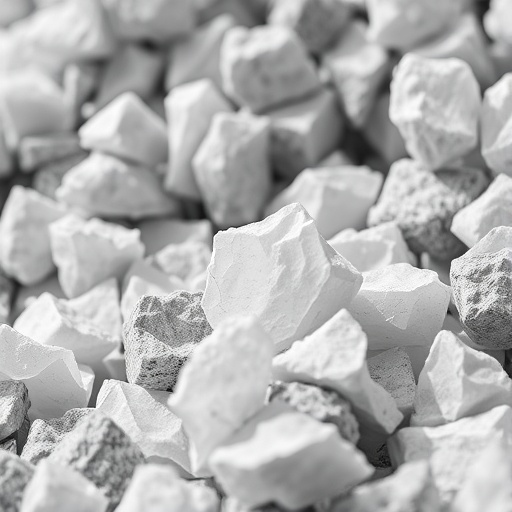
In recent years, the recycling of waste materials has gained immense importance in the realm of sustainability and energy efficiency. Among various waste products, aluminum ash has surfaced as a substantial challenge due to its disposal complexities and environmental ramifications. However, a pioneering study spearheaded by Jing et al. sheds light on the novel utilization of secondary aluminum ash, presenting an innovative approach to not just mitigate waste but also enhance the functionality of aluminum-based phase change materials (PCMs).
At the heart of this research is the synthesis and characterization of crystalline aluminum oxide (Al₂O₃) derived from secondary aluminum ash. This process taps into the inherent properties of Al₂O₃, a compound renowned for its stability, thermal conductivity, and potential as a functional additive in various applications. The researchers embarked on a meticulous journey to unlock the latent potential of this often-overlooked waste product. Through a combination of chemical processes, they were able to convert aluminum ash, which is primarily a by-product of aluminum recycling operations, into a valuable resource.
The characterization of crystalline Al₂O₃ formed from aluminum ash revealed information that is nothing short of transformative. By employing sophisticated analytical techniques, the research team identified distinct morphological and structural attributes of the synthesized Al₂O₃. The findings indicate that the synthesized crystalline structures possess not only exceptional thermal stability but also enhanced mechanical properties when juxtaposed with traditionally sourced Al₂O₃. This revelation opens up new avenues for utilizing aluminum oxide in various industrial applications, particularly as a reinforcing agent in composite materials.
Within the context of phase change materials, the incorporation of Al₂O₃ derived from secondary aluminum ash is particularly noteworthy. PCMs have garnered attention owing to their capability to store and release thermal energy efficiently, making them indispensable for applications in thermal energy storage systems. The study elucidates how the integration of this innovative material can improve the thermal performance of aluminum-based PCMs significantly. By enhancing the energy storage capacity and heat transfer efficiency, the use of aluminum ash-derived Al₂O₃ could revolutionize the design of PCM systems, thereby optimizing energy management in numerous sectors.
Moreover, the strategic utilization of secondary aluminum ash aligns harmoniously with global sustainability goals. In an era where minimizing waste and maximizing resource use are paramount, this study offers a glimpse into a viable pathway for recycling industrial by-products. By converting aluminum ash into a valuable material, the process underscores the principles of circular economy and sustainability. This metamorphosis from waste to resource not only reduces landfill burdens but also diminishes environmental pollution associated with traditional disposal methods.
The implications of these findings are far-reaching. For industries immersed in aluminum production, the feasibility of converting waste into high-performance materials heralds a promising shift towards more sustainable manufacturing practices. The integration of aluminum ash-derived Al₂O₃ in various applications could spur economic advantages, providing companies with an innovative strategy to bolster their competitive edge while adhering to environmental regulations.
An exploration of the performance studies on aluminum-based PCMs incorporating Al₂O₃ manufactured from aluminum ash reveals remarkable enhancements in thermal conductivity and energy storage capacity. The experimentations conducted highlighted the remarkable interplay between the microstructure of the crystalline Al₂O₃ and the phase change behavior of the composite material, elucidating how these characteristics influence overall thermal performance. This finely-tuned synergy is vital for maximizing the efficiencies needed in modern energy systems.
Furthermore, the application realms for this innovation span various sectors, including construction, electronics, and automotive industries. The need for advanced thermal management solutions is ever-growing, which positions aluminum ash-derived materials as indispensable components in designing energy-efficient products. The potential for broad adoption across diverse fields indicates that this research could catalyze widespread changes in material practices and manufacturing methodologies.
The energy sector, which is increasingly adopting renewable resources, stands to gain significantly from the advancement of aluminum-based PCMs. The formulated PCMs can serve as effective thermal buffers in solar thermal systems and building applications, where managing temperature fluctuations is critical to optimizing energy consumption. The research fosters a collaborative dialogue about integrating secondary materials into mainstream technologies, opening doors for future innovations that could redefine energy efficiency.
In essence, Jing and colleagues offer a timely reminder of the ingenuity that can arise from waste management while also driving forward the agenda for sustainable material utilization. Their findings not only chart a novel path for the recycling of aluminum ash but also underscore the scientific community’s role in spearheading innovations that resonate with global sustainability goals. As the world increasingly pivots toward an eco-centric paradigm, the work of these researchers could lay the groundwork for future explorations into waste resourcefulness.
In conclusion, the exploration of secondary aluminum ash transforms our understanding of waste as not just refuse but a vital source of innovation. The synthesis and characterization of aluminum oxide through this by-product exemplify the potential for fostering sustainability via advanced material science. The research encapsulates the forward-thinking approach necessary for addressing contemporary environmental challenges while paving the way for technology that can capitalize on previously underutilized resources. As we progress further into a sustainable era, studies like these become crucial blueprints for future research and development in material sciences.
Subject of Research: Secondary Aluminum Ash Utilization in Phase Change Materials
Article Title: Utilization of Secondary Aluminum Ash: Synthesis, Characterization of Crystalline Al2O3 and Performance Study of Aluminum – based Phase Change Materials
Article References:
Jing, T., Zhou, X., Kang, Y. et al. Utilization of Secondary Aluminum Ash: Synthesis, Characterization of Crystalline Al2O3 and Performance Study of Aluminum – based Phase Change Materials.
Waste Biomass Valor (2025). https://doi.org/10.1007/s12649-025-03231-1
Image Credits: AI Generated
DOI: 10.1007/s12649-025-03231-1
Keywords: Aluminum Ash, Phase Change Materials, Sustainability, Recycling, Aluminum Oxide, Crystalline Structure, Thermal Conductivity, Energy Storage, Circular Economy.
Tags: advanced material characterization methodsaluminum ash as a resource for sustainabilitycrystalline aluminum oxide applicationsenergy-efficient materials developmentenhancing functionality of waste-derived materialsenvironmental impact of aluminum wasteinnovative recycling techniques for aluminumphase change materials from aluminum ashsecondary aluminum ash recyclingsustainable waste management strategiesthermal properties of aluminum-based PCMsutilization of industrial by-products




